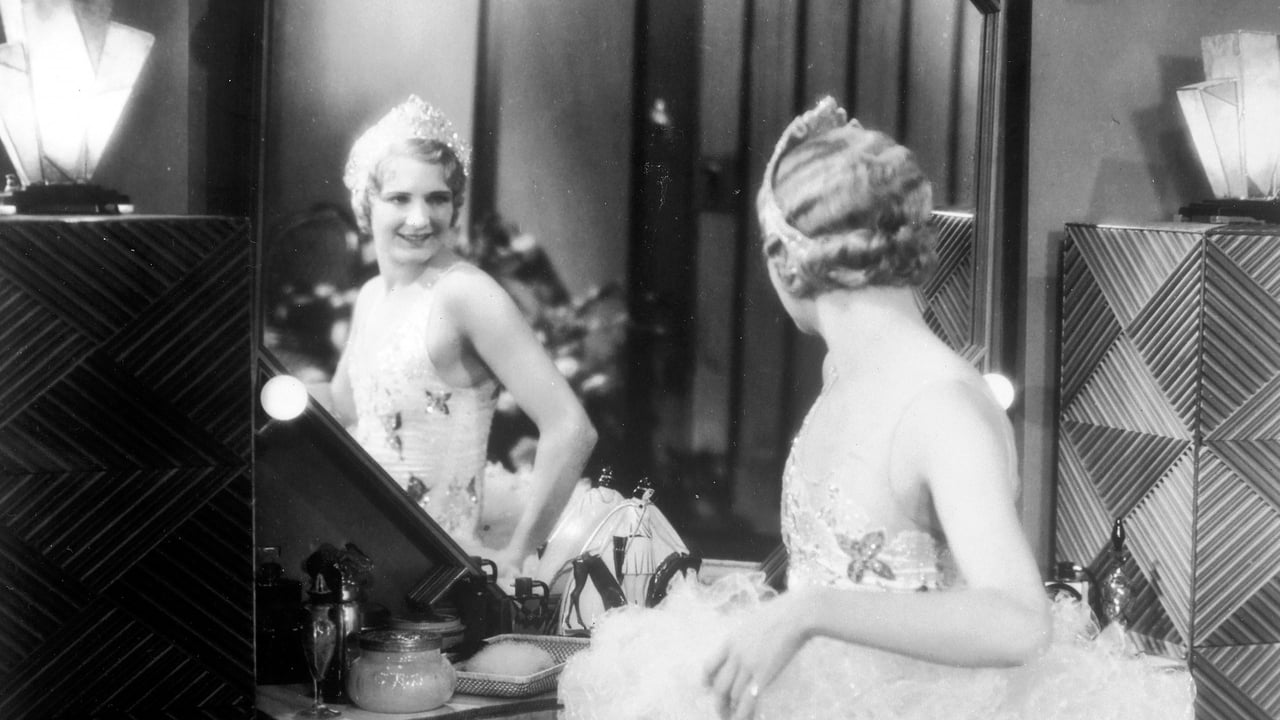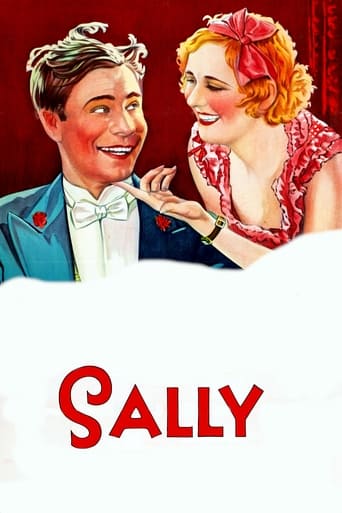

This is the first of only three films that Marilyn Miller made. Because she was the toast of Broadway, she didn't really need a Hollywood career and preferred the stage over films. Additionally, she had a drinking problem and died very young from the oddest of reasons....dying while undergoing surgery on her sinuses! So if you want to see her, this is one of your only chances.When the film begins, Sally (Miller) is a poor working girl and isn't very good at her job in the cafe. She aspires to sing and dance on stage but has yet to be discovered. The film follows her from being a waitress to being a star...and all the problems in between.Considering that it's based on the stage play "Sally" (also starring Miller) and it came out in 1929 (when sound technology was rather antiquated), the film is naturally incredibly stagy and the music is very old fashioned. While it played very well in the day, the music doesn't age all that well. It's made worse because late in the film it's one song after another after another...and they are quite tedious. Just a year or two later, sound films in Hollywood were a heck of a lot better and more timeless. Additionally, the film suffers a bit from being a black & white copy. Originally, it was filmed in Two-color Technicolor but only one brief musical sequence remains in color remains today...and it was only recently discovered.As for Joe E. Brown, this film came out before he was an established star and it looks in this movie as if Warner Brothers really didn't know what to do with him. He's much more a supporting character and plays, oddly, a broke playboy and member of the royalty who's working incognito in the cafe!Overall, this film is more of a curio...and oddity, as opposed to a film folks would want to see. Not a terrible film but a difficult one to love, that's for sure.
... View MoreMarilyn Miller was the most famous Broadway musical star of the early part of the last century - too bad for most of us she died so young. She made three motion pictures in the late 20's/early 30's which survive and can give us an indication of what made her such an acclaimed talent.In 1929 she made "Sally" for First National (forerunner of Warner Bros.) in which she recreated one of her stage triumphs. It is good and with some competent back-up supporting actors, but I would say it is an incomplete document if one is trying to 'discover' Marilyn Miller. The story is familiar, about a waitress looking for her big show biz break with a romantic side-story, and she shows her star appeal as a passable singer, a better actress and an even better dancer. She is pretty in a familiar sort of way, but she wins you over with her vivacious, cheerful demeanor. The website rating is about right, and you get the feeling that being captured on film in an unremarkable story doesn't do her justice. I haven't seen her other films but I am reasonably certain that they do not capture the full impact of this legendary performer, either. I guess we'll just have to rely on historical sources and those three films.
... View MoreSally was made at the very end of 1929, and it is impressive to see how far sound technology has come in just one year. Although this film still used the Vitaphone sound on disc system that usually resulted in very static scenes, Sally has a high amount of fluid motion present that is uncharacteristic for a film made at this time. Sally's film elements are in somewhat shaggy shape, as is true of many of the early talking First National films. However, it is a very good and rare record of the singing, dancing, and even acting talents of Marilyn Miller and a very good musical in its own rights. The story is adapted from the Ziegfeld show of the same name. It is about Sally Green (Marilyn Miller), an orphaned girl who waitresses and cooks in a diner for a living, but dreams of being a professional dancer. In fact, the very first shots of the film are of Miller's feet as she dances while she works. She also has an admirer (Alexander Grey) who stares at her from outside the café where she works, causing her to get so enthralled in his gaze one day that she inadvertently makes the world's largest pancake. Sally is basically a Cinderella story, and a charming one at that. There is no evil stepmother in this fairy tale, however, so you can just sit back and enjoy this light romantic comedy and its beautiful musical numbers. The romance is provided by Alexander Gray and Marilyn Miller, and the comedy is mainly provided by Joe E. Brown. Brown plays a prince made penniless by a revolution in his country of origin who now works at the restaurant with Sally and is also her good friend. One of the most delightful scenes in the film is where the two dance to "Look for the Silver Lining" with Miller doing her more formal interpretation alongside Brown's eccentric dancing.Someone else compared Marilyn Miller to Irene Dunne, and there is one scene where that is particularly true. An agent has a famous dancer client who has run out on him the night before she is to perform at a big society party. Sally helps him out by impersonating that dancer complete with a ridiculous accent and an outlandish headdress. This comedy bit very much reminded me of something Irene Dunne would do. The film was originally shot in two-strip Technicolor, but only one color scene still exists. That one scene is Miller dancing to "Wild Rose" at a society party, and the colors there are truly splendid. As soon as the Technicolor kicks in, for some reason, so does a higher quality level on the sound. Highly recommended for the fans of the early talkie musicals.
... View MoreThis is one early sound film that fortunately is not lost because it gives us the opportunity to see one of the biggest Broadway stars of her era give her breakout performance. Too many people have forgotten Marilyn Miller, she was the Madonna of her day in more ways the one.And in 1919 Sally was the role that made her a Broadway star. It's a Cinderella story, the kind that was popular back in the day. She's a foundling, raised in an orphanage and working as a dishwasher/server at a café where she's discovered. She finds stardom in the Ziegfeld Follies where Marilyn Miller actually did appear and the man of her dreams in Alexander Gray.Of course it's not all smooth sailing and the girl does have to do a stint at a society party masquerading as a fortune hunting dancer from Europe, an idea press agent T. Roy Barnes dreams up when the real dancer who's his client runs out on him. You might remember Barnes best from a small role in It's A Gift where he tries to sell a weary W.C. Fields some insurance. On stage the part was played by Walter Catlett.This was also the film that brought Joe E. Brown a long term contract with Warner Brothers/First National as their leading comic star in the Thirties. Playing a role originated on Broadway by Leon Errol, Brown is the prince of Czechoslovenia who lost the family fortune on fast women and slow horses. He still has the title, but works in the same café as Miller run by an exiled subject Ford Sterling who has some trouble adjusting to the new relationship between prince and former commoner. Miller and Brown have a very good dance number.Speaking of dance that was Miller's real forte. A good singer, she was a terrific dancer as this film shows. In fact because she felt that audiences did not get the full effect of her persona unless they saw the whole act on stage, she refused to make records. Thus her three films with Warner Brothers/First National are the only record we have of her performing. Seeing her dance I understand though don't agree with her point of view.In fact the main problem with Sally is that when Miller did the Broadway show she was a fresh young 21 in 1919. She's now 31 and she partied hardy in the Roaring Twenties. The talent is there, but she looks like a 31 who's seen a bit of the sunny and shady side of life.Of course her signature song, Look For The Silver Lining which Jerome Kern and Buddy DeSylva wrote for her in this show is there. Most of the score is not and two new songs from Joseph Burke and Al Dubin are. One of them, If I'm Dreaming, Don't Wake Me Up Too Soon was revived almost 60 years later and heard as background music during the Oscar ceremony scene in the Bruce Willis-James Garner film Sunset.If people remember Marilyn Miller at all, they remember Judy Garland portraying her in Till The Clouds Roll By and from the biographical film that Warner Brothers did in 1949 with June Haver as Marilyn. Also in MGM's The Great Ziegfeld, the Virginia Bruce character is based on Marilyn Miller. Here's a chance to see the real deal so don't pass it up.
... View More